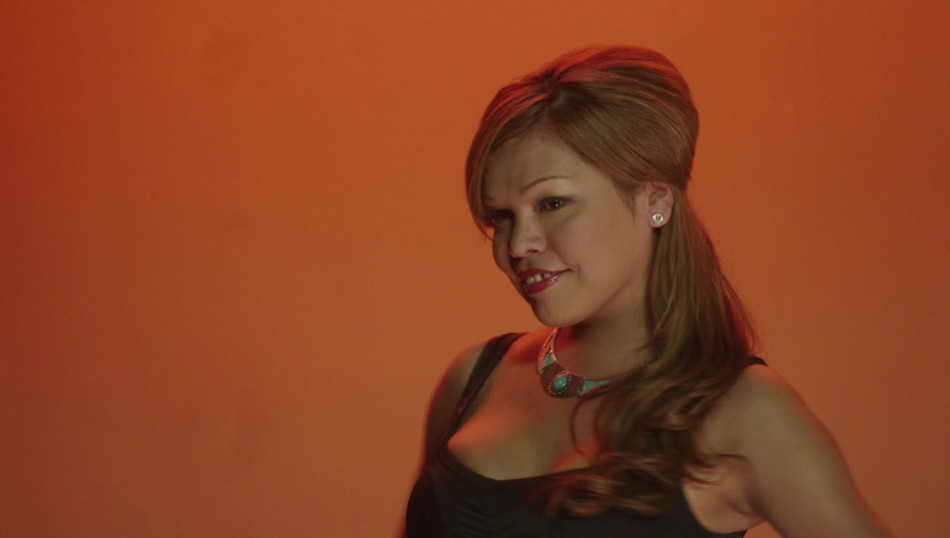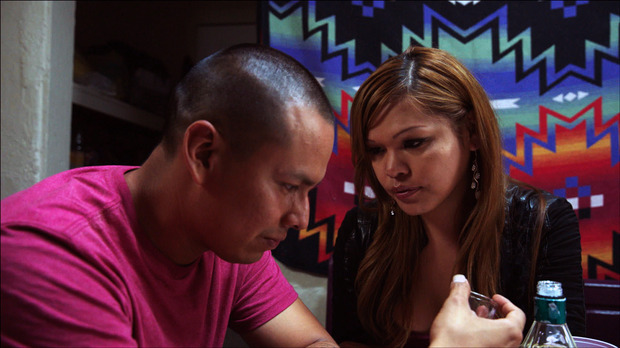
Carmen Moore plays Felixia in Drunktown's Finest
Drunktown’s Finest: Why Not A Documentary?
Drunktown’s Finest takes you to Navajo and into a knot of intersecting lives. It’s a mosaic of compounded anguish, for which a grim ending seems predestined. Perhaps, for some lucky folk, it’s not always inevitable. That’s as reassuring a message as we can take from director Sydney Freeland’s amateurish melodrama, which premiered at Sundance 2014. (The movie which was six years in production and raised partial funds on Kickstarter, was shot in Santa Fe, Gallup and Espanola.)
Like so many films made in and about New Mexico, this one opens under the vast radiant sky. The closer to the ground you get, the radiance fades into hardscrabble and meager opportunities. The structure is one of interlocking stories. We’ve seen this kind of ensemble narrative before, and we’ve seen a lot of the acting, too. The cast of characters draw emotions, it seems, from a lot of other movies that they’ve seen.
SickBoy (Jeremiah Bitsui) is one of the many young Navajos who is trying to get out. He’s signed up for the Army — to help support his pregnant wife and the child they expect — but when a police officer stops him in a mini-mall parking lot, he takes a swing at the cop. Things go way downhill from there.
 Nizhoni (Morning Star Angeline) talks like an “assimilated” Indian, and it turns out that she was given up by her grandparents and sent to live in Michigan. Now she’s back on the rez, on summer vacation from Calvin College (a bastion of American Calvinism, in case you don’t know it) and she gets a taste of real life when doing the community service that the school requires — on a crew cleaning up some interesting road kill. She’s in for some surprises, which I won’t give away, and not all of them are scraped off the highway.
Nizhoni (Morning Star Angeline) talks like an “assimilated” Indian, and it turns out that she was given up by her grandparents and sent to live in Michigan. Now she’s back on the rez, on summer vacation from Calvin College (a bastion of American Calvinism, in case you don’t know it) and she gets a taste of real life when doing the community service that the school requires — on a crew cleaning up some interesting road kill. She’s in for some surprises, which I won’t give away, and not all of them are scraped off the highway.
One of the most appealing folks trying to find his or her way out is Felixia (Carmen Moore), once known as Felix, a transgender woman whose path to other places is a Navajo beauty pageant. Moore plays deftly with gray shades of desire, although Freeland seems to have a tin ear for the dramatic possibilities of a beauty pageant audition for a transgender contestant. We get a little more depth and complexity as we learn of one young married Anglo’s attraction to Felixia, who is also the object for desire for some bad-ass homies who ride around drinking and doing drugs.
As you might expect, Freeland (of Gallup, NM) is deeply earnest here; the story was generated by her reading Gallup dubbed “Drunktown U.S.A.” in a newspaper. All sorts of characters end up doing things wrong — mostly through substance abuse and the ensuing range of misdeeds — for what seem to be reasons born of poverty and emotional neglect. The film succeeds in helping you see the near-infinite ways that life for young Navajos can be tough.
It’s a good question about how you’d expect most people to find their way out? But what about finding their way out of the belabored script?
Sundance Labs has made developing Native American film in New Mexico a special mission — but the risk is preachy political correctness that turns each story into a fraught cry for help. The participants convey the urgency of whatever crises they’re depicting. But that’s the problem; they’re trying too hard.
The cinematography stands above much else in Drunktown’s Finest, but the hyper-realistic production design doesn’t seem to have involved much more than setting up the camera. There’s an obvious question here: Why not make a documentary? No doubt the filmmaker and her team were after a dramatic truth which goes beyond the earnest expositional docs that have been there before.
Assuming that most of the audience doesn’t know life on Navajo or in Gallup, what we get are images of the place that read somewhat familiar from past movies, and we get the lives from scripted characters who are living it. The amateur acting doesn’t gain us much. A documentary about the making of a film from the script might have been a more productive approach.
